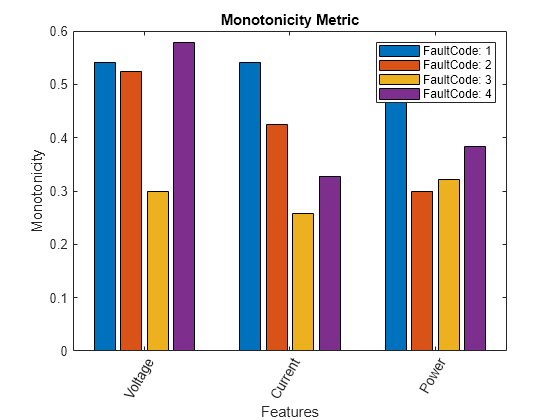monotonicity
Quantify monotonic trend in condition indicators
Syntax
Description
Y = monotonicity(X)X. Use
monotonicity to quantify the monotonic trend in condition indicators
as the system evolves toward failure. The values of Y range from 0 to
1, where Y is 1 if X is perfectly monotonic and 0
if X is non-monotonic.
As a system gets progressively closer to failure, a suitable condition indicator typically has a monotonic trend. Conversely, any feature with a non-monotonic trend is a less suitable condition indicator.
Y = monotonicity(X,lifetimeVar)X using the lifetime
variable lifetimeVar.
Y = monotonicity(X,lifetimeVar,dataVar)X using the data
variables specified by dataVar.
Y = monotonicity(X,lifetimeVar,dataVar,memberVar)X using the lifetime
variable lifetimeVar, the data variables specified by
dataVar, and the member variable
memberVar.
Y = monotonicity(___,Name,Value)Name,Value pair arguments. You can use this syntax with any of the
previous input-argument combinations.
monotonicity(___) with no output arguments plots a
bar chart of ranked monotonicity values.
Examples
Input Arguments
Name-Value Arguments
Output Arguments
Limitations
When
Xis a tall table or tall timetable,monotonicitynevertheless loads the complete array into memory usinggather. If the memory available is inadequate, thenmonotonicityreturns an error.
Algorithms
References
[1] Coble, J., and J. W. Hines. "Identifying Optimal Prognostic Parameters from Data: A Genetic Algorithms Approach." In Proceedings of the Annual Conference of the Prognostics and Health Management Society. 2009.
[2] Coble, J. "Merging Data Sources to Predict Remaining Useful Life - An Automated Method to Identify Prognostics Parameters." Ph.D. Thesis. University of Tennessee, Knoxville, TN, 2010.
[3] Lei, Y. Intelligent Fault Diagnosis and Remaining Useful Life Prediction of Rotating Machinery. Xi'an, China: Xi'an Jiaotong University Press, 2017.
[4] Lofti, S., J. B. Ali, E. Bechhoefer, and M. Benbouzid. "Wind turbine high-speed shaft bearings health prognosis through a spectral Kurtosis-derived indices and SVR." Applied Acoustics Vol. 120, 2017, pp. 1-8.
Version History
Introduced in R2018b


